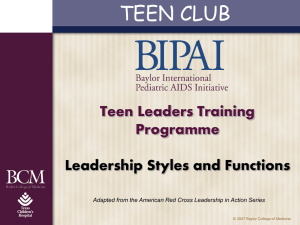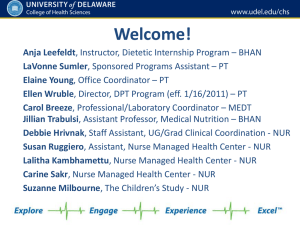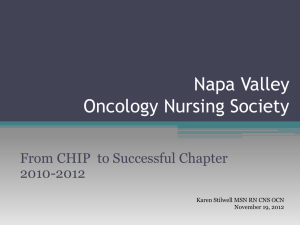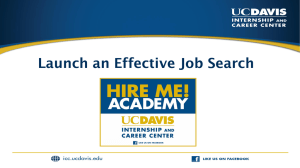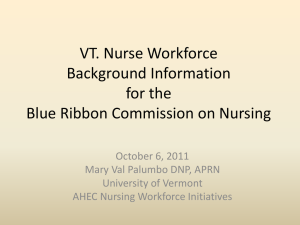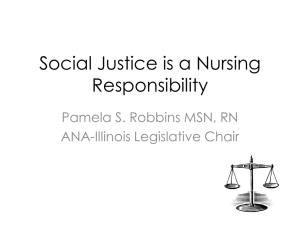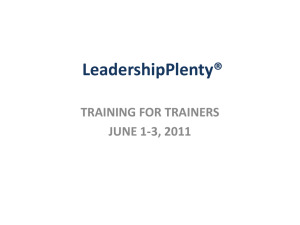Resume Writing 101 - Baylor University
advertisement
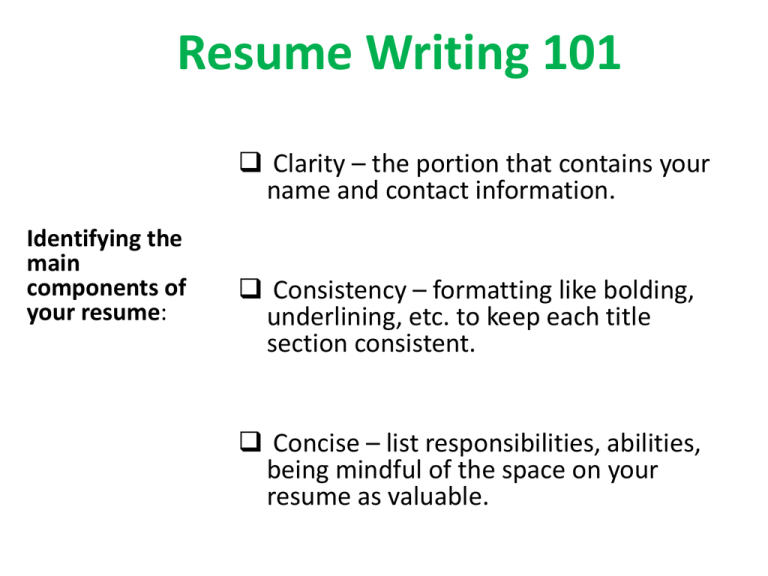
Resume Writing 101 Clarity – the portion that contains your name and contact information. Identifying the main components of your resume: Consistency – formatting like bolding, underlining, etc. to keep each title section consistent. Concise – list responsibilities, abilities, being mindful of the space on your resume as valuable. Clarity: the main component of your resume, the imperative initial introduction, and the listing of your contact information! Resume Heading Betty Baylor 3700 Worth Street ● Dallas, TX 75246 ● 214-820-3361 ● Betty_Baylor@Baylor.edu The header you use for your resume should be the exact header used for every other document you submit for employment consideration – references, cover letters, etc. Resume Titles Consistency: the theme of your resume that makes reading specific sections easier and eye-catching! Betty Baylor 3700 Worth Street ● Dallas, TX 75246 ● 214-820-3361 ● Betty_Baylor@Baylor.edu Education: Baylor University Louise Herrington School of Nursing Clinical Experience: Baylor University Medical Center Professional Experience: Baylor University Success Center Tutor Certifications: CPR and BLS Certified for Health Care Providers Resume Qualifications Betty Baylor 3700 Worth Street ● Dallas, TX 75246 ● 214-820-3361 ● Betty_Baylor@Baylor.edu Concise: Bulleted lists can be a way to simplify your information and quickly convey a message of competence and professionalism Education: Baylor University Louise Herrington School of Nursing Bachelor of Science in Nursing May 2014 Clinical Experience: Baylor University Medical Center Med/Surg Clinical Fall 2013 Professional Experience: Baylor University Success Center Tutor Student Mentor/Tutor 2012-2013 ● Provided tutoring in English major ● Developed mentoring guide ● Conducted test prep sessions ● Led group study workshop Certifications: CPR & BLS Certified for Health Care Providers 2013 Certified Nursing Assistant credential 2013 Resume Overview Education – do you have the required degree, if not, do you have a target date for when you will obtain that degree; Clinical Experience – this is more nursing-specific and important to show that you have been in the clinical setting for multiple areas of nursing; Professional Experience – if you do not have a formal job that you have worked/served in the past, volunteer service/work would be a great substitute, but be sure to list it as “volunteer experience” in place of the professional experience title (side-note: do not discount any work at a service industry job like Starbucks, because the same patrons you provide service to on that job will be the same people coming into the ER that you encounter and you will need to serve those same people again); Certifications, skills, memberships, etc. – this is the more “catch-all” area of the resume, but still important - remember we are thinking of this document as something that speaks for you when you are not present, so anything you add here should be targeted toward displaying competency, qualification, training, etc. Professional Resume – the final product Betty Baylor 3700 Worth Street ● Dallas, TX 75246 ● 214-820-3361 ● Betty_Baylor@Baylor.edu Education: Baylor University Louise Herrington School of Nursing Bachelor of Science in Nursing May 2014 Clinical Experience: Baylor University Medical Center Med/Surg Clinical Fall 2013 Professional Experience: Baylor University Success Center Tutor Student Mentor/Tutor 2012-2013 ● Provided tutoring in English major ● Developed mentoring guide ● Conducted test prep sessions ● Led group study workshop Certifications: CPR & BLS Certified for Health Care Providers Certified Nursing Assistant credential 2013 2013 Review & Tips for Applications • Always name any document that you upload with an electronic application your first and last name and the title of the document – ex. Jeanny Powell Resume; • Before uploading any document for electronic applications, be sure to save the document as a PDF so the margins, spacing, font, etc. will not be altered; • If references are required, format the reference list with the same header used for your resume and classify each reference – ex. Professional Educational Personal • Always ask before listing anyone as your reference and do not forget to use that person’s credentials & professional title – ex. Bart Baylor, PhD Vice President • You may need to request a letter of recommendation from your instructor and the form is on the 3rd floor in the administrative suite – be mindful of the time you submit a request to the date of your interview. Cover Letters • Cover letters can actually be used in lieu of an objective statement on your resume because the whole purpose of a cover letter is to introduce your passion for nursing. • Keep your cover letter short with an intro about why you are writing: to apply for the job, second, how you are a good fit for the job requirements listed in the posting, and last, being thankful for the nurse recruiter’s time to review your credentials. Use the closing to show your enthusiasm for the company and to sell yourself as the ideal candidate and DO NOT forget to attach your resume if sending via email. • There are not enough ways to put your contact information out in a cover letter – use your Baylor email so it does not go to spam folders, but include your contact info on your header and state the number and email again in the closing paragraph. The easier you make it for them to contact you, the higher the likelihood that they will call you back! • Spell check and proof your thank you letter. Then ask someone else to proof it for you. That way you will be sure it's perfect. Thank You Letters • Thank you letters can be handwritten, typed or sent via email. Each thank you letter should include a thank you for the interview, your interest in the jobs, your qualifications and skills, and a final thank you. • Keep your thank you letters short and simple, but, do use the letter to reiterate your interest in the job, your enthusiasm for the company and to sell yourself as the ideal candidate. • Spell check and proof your thank you letter. Then ask someone else to proof it for you. That way you will be sure it's perfect. References Technique of Three Problem – what was the issue? Solution – what did you do about the problem? Outcome – what did you learn from this issue? Reminder: NEVER bash the person, place, or thing, that is included in the story in a negative light – you can explain the situation from the other person’s perspective or find a positive outcome from the experience, like how you approach the same situation differently now. Questions for Interviewer • Training and support? • What is the ideal candidate? • How long before I can expect to hear back? Always, always, always, always attach a PDF of your resume when emailing a recruiter – it reminds them of who you are and makes it easier for them to contact you! Reminder of Nursing School Dress Code The uniform dress code is designed to assist the students and the faculty to maintain consistency in dress attire as is considered appropriate and safe for professional nursing practice. When representing the School of Nursing in the hospital and the community, students are expected to adhere to dress codes as specified by the LHSON Uniform Dress Code. When representing the School of Nursing during class lectures or labs held at BUMC, Sammons Cancer Center, and/or BGCT, the student is required to wear either the Clinical Full Uniform or the Partial Uniform. (See descriptions below.) Students are to wear their uniform only when in class, clinical, or lab settings. Students are not to wear BULHSON uniform, lab coat, patches or pins when outside the class, clinical, or lab setting or when working in hospitals or other health care agencies for pay. (Example when not to wear uniform: volunteering at soup kitchen, eating out with friends, shopping at the mall, etc.) Students are role models and should be clean, neat, and wellgroomed at all times. Specific requirements are stated in the following outline: Reminder of Nursing School Dress Code Clinical Full Uniform 1. Women: white uniform dress, skirt or split skirt and matching top, white pants and matching top OR green scrub top with green pants or skirt. Students may wear the matching green warm-up jacket. A plain white t-shirt under scrub top is recommended so as not to reveal midriff or cleavage. Appropriate length for skirts, split skirt or dress uniform is knee length to mid-calf. No sweaters on clinical units. 2. Men: Landau brand only white or green scrub top and white or green Landau brand pants. The uniform dress code is designed to assist the students and the faculty to maintain consistency in dress attire as is considered appropriate and safe for professional nursing practice. When representing the School of Nursing in the hospital and the community, students are expected to adhere to dress codes as specified by the LHSON Uniform Dress Code. When representing the School of Nursing during class lectures or labs held at BUMC, Sammons Cancer Center, and/or BGCT, the student is required to wear either the Clinical Full Uniform or the Partial Uniform. (See descriptions below.) Students are to wear their uniform only when in class, clinical, or lab settings. Students are not to wear BULHSON uniform, lab coat, patches or pins when outside the class, clinical, or lab setting or when working in hospitals or other health care agencies for pay. (Example when not to wear uniform: volunteering at soup kitchen, eating out with friends, shopping at the mall, etc.) Students are role models and should be clean, neat, and well-groomed at all times. Specific requirements are stated in the following outline: Reminder of Nursing School Dress Code Clinical Full Uniform 1. Women: white uniform dress, skirt or split skirt and matching top, white pants and matching top OR green scrub top with green pants or skirt. Students may wear the matching green warm-up jacket. A plain white t-shirt under scrub top is recommended so as not to reveal midriff or cleavage. Appropriate length for skirts, split skirt or dress uniform is knee length to mid-calf. No sweaters on clinical units. 2. Men: Landau brand only white or green scrub top and white or green Landau brand pants. 3.Both hunter green and white scrubs should be Landau brand only. Pants should be style number 8550, 7602, 8335, tops should be style number 7502 or 8219. Hem of pants should NOT touch the floor. • Style 8550 Style 7602 Style 8335 Style 7502 Style 8219 4. Landau brand Scrub Jackets in unisex style number 7525, are permissible and the Baylor University Louise Herrington School of Nursing patch must be sewn around the edges on the left sleeve(midway between left shoulder and elbow). • Style 3124 • Men’s Lab coat Style 3155 • Women’s Lab coat Style 7525 • Unisex Scrub Jacket Reminder of Nursing School Dress Code 4. Landau brand Scrub Jackets in unisex style number 7525, are permissible and the Baylor University Louise Herrington School of Nursing patch must be sewn around the edges on the left sleeve(midway between left shoulder and elbow). • Style 3124 • Men’s Lab coat Style 3155 • Women’s Lab coat Style 7525 • Unisex Scrub Jacket 5.White lab coat with Baylor University Louise Herrington School of Nursing patch sewn on left sleeve (midway between left shoulder and elbow). Lab coat should be Landau brand only in style number 3124 for Men and 3155 for Women. Shirt sleeves should not extend below the edges of the lab coat sleeve. 6. Plain white or black hose or socks for women, white or black socks for men with no visible designs. Socks/hose should match the color of the students shoes. 7. Clean, white or black non-permeable nursing shoes or all white or black leather tennis shoes, no mesh insets. Open toed shoes are not acceptable. Open backed shoes are not recommended. 8. Designated Baylor University Louise Herrington School of Nursing name pin and picture ID as dictated by assigned clinical site. 9. Baylor University Louise Herrington School of Nursing patch sewn around edges on left sleeve (2 inches below shoulder seam, centered on the sleeve). All uniform tops, Jackets and lab coats must be Landau brand only and should have patch attached. 10. Full uniform is required for pre-clinical assessment. Pediatric clinical uniform on Level 3 is Landau brand white or green uniform pants with print top as designated by individual clinical faculty. Requirements for psychiatric clinical dress code on Level 3 will be provided by each individual instructor. Partial Uniform (for community experiences, field trips, class attendance at BGCT, BUMC, or Sammons Cancer Center, etc.) ** All hair, jewelry, and nails standards apply to partial uniform guidelines as well as full uniform guidelines Reminder of Nursing School Dress Code 1. Lab coat over professional business attire. No open toe shoes. 2. Blue jeans or denim style jeans, mini-skirts, sleeveless shirts, shorts, T-shirts, jogging outfits, thong sandals, etc., are NOT acceptable for clinical or when obtaining a clinical assignment the day before clinical. 3. Designated Baylor University Louise Herrington School of Nursing name pin. Hair 1. Hair must be well groomed and restrained from face. Only naturally occurring hair color is acceptable. 2. Well-groomed beard. Nails 1. Nails must be well groomed and cannot extend beyond the length of the fingertips. 2. Nail polish is NOT permitted of any type(even clear) 3. Artificial fingernails or permanent/semi-permanent nail decorations will not be worn in any clinical areas where client contact will take place. Allowable Jewelry 1. Watch with second hand. 2. Wedding or engagement band (no protruding stone). 3. Class ring. 4. One pair of studs or small earrings. 5. No visible body piercing, temporary or permanent body art (tattoos) is acceptable. Tattoos should be covered. Tongue rings are not acceptable. Miscellaneous 1. No perfume, body lotions and aftershave are to be worn in the clinical setting. Avoiding common mistakes includes being mindful of what you say, how you answer questions, and communicating your level of competence. The nurse recruiter wants you to engage, so maintain eye contact, remember to smile, and you can ask him/her to repeat questions during the interview if necessary. The interview will almost always include a question that pertains to conflict, negative situations, tense interactions, personality clash, etc. The way to answer the negative scenario question is with a positive spin on what you learned. Never bash the person, place, or thing you are talking about. You can answer by using words that describe the situation without any personal opinions or commentary about the situation. Ex. “The patient was upset did not agree with the intervention that was required, so I sat down with him and explained why we needed to do the procedure and explained what would happen if we did not intervene. After I took the time to explain, the patient was still unhappy, but he understood why it needed to be done and eventually agreed to the intervention.” Mainly, the interviewer wants you to demonstrate the common goal , which is the best patient care. Also, you want to show that you know that not every situation has a positive outcome, but that you are still able to learn from the conflict. Attention to detail is key, so always check anything and everything you submit for typographical errors, misspellings, and correct facility name, address, recruiter title/credentials, etc. These are small measures to take and are guaranteed to help you if you utilize them or if you do not double-check, your application will most likely be overlooked. Make it a habit of checking for all of these errors on every application. Past work experience is always valuable. Never discount a job because it was a restaurant because the same people that you serve in restaurants are the same people that you will encounter in the hospital. In your restaurant job, you still learned the basics of serving individuals and that is valuable. If you are unable to relay a story about an experience in the clinical, hospital, or medical arenas, do not omit experience gained in a job outside of nursing. If you have a great customer service story from a fast-food job, pull from that experience because it has value and can demonstrate your ability to interact with dissatisfied patients, their families, and coworkers. (From the viewpoint of the hiring manager/nurse recruiter) Did you attach/upload your resume with the application? Are you passionate about this floor/unit? If I place you in this job, will you be a good fit? Do you know anything about this facility/unit? Why do you want to be a part of this team? What can you offer/contribute to this team? If we invest training/time, will you stay in this job? Is the care of the patients your top priority? Resume: potential employer’s first impression of you. Think of your resume as a document that speaks for you when you are not in the room, so make your contact information easy to find, include your education and any degrees earned, list your clinical experience, and list brief descriptions of your work or volunteer experience. Cover letter: displays interest in the job & shows your skill set. Utilize your cover letter to show your passion for the position that you are applying for and briefly describe how your education, skills, or previous experience make you a good fit for the position. Effectively preparing for interviews is easy, but takes a bit of planning, so here are some tips: Get a pocket folder to put at least five extra copies of your resume in one pocket (if you have fancy paper, this would be the time to use it) because you never know how many interviewers you may have and it is better to be over-prepared; Get at least five extra copies of your list of references (see template on career services webpage for examples) to put in the other pocket of your folder; Make a list of at least three to five questions for the end portion of the interview when they ask the inevitable: “do you have any questions for us”? (see career services webpage for sample prospective employer questions); Keep a copy of your resume with notes for yourself to “jog” your memory of any specific stories or examples you want to pull from previous experience/training that might be forgotten due to nerves; When you email a recruiter, whether it is to follow up, ask a question, whatever, ALWAYS attach your resume – the easier you make it on them to remember you, the easier it is for them to reach out and contact you; Have a pen tucked into the spine of the folder to take notes during the interview; and Ask for a business card before you leave so you will have the official job title, credentials, and business address to send the interviewer a thank you letters after the interview.
